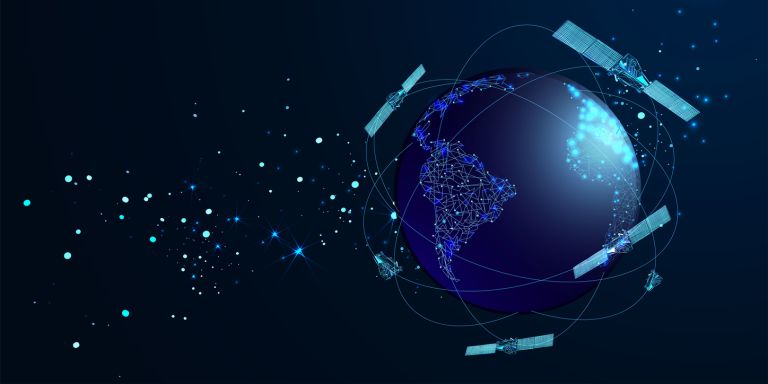
- Home
- Digital transformation
- Iris2: the architecture of the European Internet constellation soon to be revealed
Iris2: the architecture of the European Internet constellation soon to be revealed


The shape of Europe’s future internet constellation was a hot topic at the 16th European Space Conference, held in Brussels on 23 and 24 January, with a round table discussion featuring key players in the European space industry. The European Commission is due to receive their proposal by February 14.
The European Commission approved the « Breton Constellation », as it has often been colloquially known, just two years ago, and it is now about to take a decisive step forward. In mid-February 2024, the major industry players (Airbus DS, Thales Alenia Space, Hispasat, SES, T-Systems and Eutelsat) will submit their final draft to the Commission. However, the twelve-year contract will not be signed until March 2024, as Thierry Breton, European Commissioner for the Internal Market, explained briefly before the panel.
The panelists remained tightlipped about the details of their proposal, which would operate as a public-private partnership (PPP). Nevertheless, some information is beginning to emerge. The architecture chosen for Iris2 (Infrastructure for Resilience, Interconnectivity and Security by Satellite) could consist of at least two hundred satellites distributed over low (LEO), medium (MEO) and geostationary (GEO) orbits, whereas Starlink currently operates solely in low earth orbit.
Although there are no official details at present, Iris2’s low-Earth orbit coverage will require a backbone of at least 170 satellites. « This is an order of magnitude for continuous coverage of the Earth, » says Christophe Allemand, who works in the European Space Agency’s (ESA) Connectivity and Secure Communication Directorate. In medium orbit, around 30 satellites would be needed, « but there will be a higher latency than in LEO« , Allemand says.
In terms of weight, the Starlink and OneWeb satellites are small (150 kilos for the latter and 1.2 tons for Starlink V.2.0), so future Iris2 relays could also follow this pattern. Furthermore, the satellites are expected to be compatible with the 5G standards used by terrestrial telecoms operators so that they can be integrated with other communications systems, unlike Starlink, which operates in a closed circuit. But the winning proposal will be « the one that offers the most relevant architecture for the European Union and the consortium’s trading partners« , says Christophe Allemand.
For the record, IRIS2 is set to become Europe’s third satellite component, after the Galileo (geopositioning) and Copernicus (Earth observation) systems. Its main mission will be to guarantee the security of government telecommunications and public services while providing global Internet coverage.
An advantage for Europe
One of the main stakes behind Iris2, which involves €6 billion in funding over 12 years,* is to safeguard Europe’s sovereignty, including in areas of major importance to the continent, such as Africa and the Arctic. At the 2022 Space Conference, Commissioner Breton stated that « we will provide access to all Europeans by putting an end to dead zones« . Moreover, « the Iris2 constellation is important for Europe because space is strategic. It’s an advantage, » says Ruy Pinto, CEO of Luxembourg-based operator SES. It aims to provide a service that can prove critical in times of natural disaster or conflict.
Starlink, for example, is largely subject to the decisions of its CEO (Elon Musk), who can arbitrarily choose to stop providing access to its service. In September 2023, he decided to cut off the Ukrainian government’s access to its network during a drone attack on the Russian fleet deployed in the Black Sea. For Europe, it will ensure that the service will be available to its critical users in a way that is decided in Brussels by the governance of the Member States.
Secondly, the Iris2 constellation will also be able to provide services to the armed forces. « The constellation will be capable of carrying military payloads« , says Thierry Breton. He also noted that the war between Russia and Ukraine, which began two years ago, demonstrates Member States’ need for a constellation designed for military purposes.
Going fast
In addition, space may be reserved in the satellite design for additional payloads, notably for observation missions (Hosted Payload). « But this will depend on the call for ideas and who is willing to invest, » says Marc-Henri Serre, executive vice-president of telecommunications at Thales Alenia Space (TAS). Such a process has already been used in the past, for example on the Copernicus program, to fit the Sentinel 4 payload on the two third-generation Meteosat MTG-S (S for sounder) satellites currently under development at Thales Alenia Space in Cannes.
When it comes to security, Iris2 will be protected « thanks to our new-generation cryptographic systems« , says Marc-Henri Serre, without giving any further details. However, it will not involve TeQuantS quantum technology, also being studied by TAS. This is not expected to be mature « until around 2030 or 2035« .
More than one launcher needed
And time is of the essence because Iris2 is due to be deployed as early as next year, but it depends on the arrival of Ariane 6 (although the first services will be available via the EU’s GovSatcom initiative from the end of this year). After a decade of development (and almost four years’ delay), Europe’s new heavy launcher is due to make its debut on June 15, 2024. Steven Rutgers, Arianespace’s Chief Commercial Officer, confirmed during the round table that Ariane 6 was preparing for its maiden flight. The main components of the first flight model (FM-1) – the upper and middle stages – are « almost completely » integrated at ArianeGroup’s German (Bremen, in particular) and French (Les Mureaux) facilities.
They will be shipped to the Guiana Space Center by the vessel Canopée within the next few weeks. « But to deploy the satellites (of the constellation), we need two things, » says Ekaterini Kavvada, Director for Space Development and Innovation at the European Commission. « A European launcher (Ariane 6), but we need more than one launcher, » she adds.
This suggests that Iris2 will also be deployed with European mini-launch operators. Currently, Spain’s PLD Space is the only operator on the continent to have completed a suborbital flight with its Miura-1 rocket, having done so on October 7, 2023 after twelve years of development. Its Miura-5 orbital system is due to fly for the first time from French Guiana in 2025. Ekaterini Kavvada also emphasized that as soon as these operators are ready, they should support Arianespace in deploying the constellation, which is due to be fully operational by 2027.
*In this PPP, the EU will contribute €2.4 billion over 12 years, ESA €750 million, with the remainder (60%) coming from industry.
the newsletter
the newsletter


